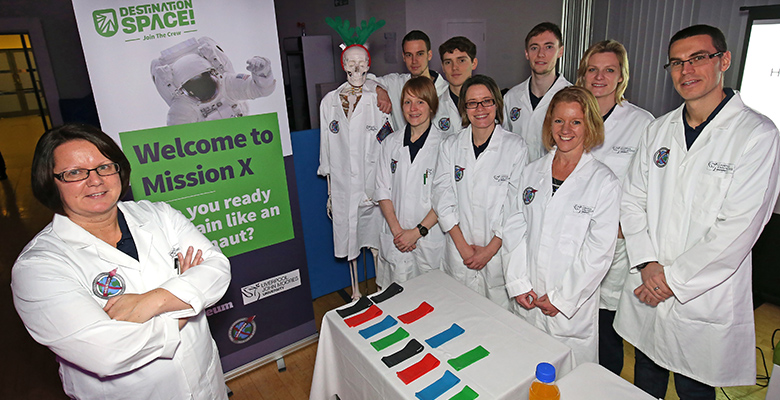Reaching for the stars
Sport scientists and astrophysicists prepare school children for demands of space travel

As hundreds of school children gathered to watch Tim Peake’s launch into space at World Museum, Liverpool John Moores University’s sports scientists and astrophysicists were on hand to deliver expert scientific knowledge and interactive workshops explaining what is behind space travel.
Children gathered to watch a live broadcast of the rocket launch, before taking part in a series of interactive activities designed to teach them about life on the International Space Station, and the fascinating science behind human space flight.
A team from the School of Sport and Exercise Sciences brought public engagement project ‘Mission X’ to World Museum so that children could learn how to ‘train like an astronaut’. This international learning challenge focused on fitness and nutrition in preparation for the demands of space travel. This included pre-flight medical checks like heart rate monitoring and hydration, gravity, balance and resistance games.
Professor Andrew Newsam from the Astrophysics Research Institute closed the day’s events with a talk revealing how modern technology is opening up a view of the Cosmos on a scale that astronomers would never have believed possible, just a couple of generations ago.
Reader in sport and exercise psychology, Dr Zoe Knowles, who is also a Network Co-ordinator for the National Co-ordinating Centre for Public Engagement, commented:
"The LJMU School of Sport and Exercise Sciences is always keen to bring our knowledge to the public and especially to inspire children and young people, giving them both fun and educational opportunities to learn. We want to show just how many careers there are in science and bring our extensive experience of working with some of the worlds best athletes to interactive sessions that can engage all ages."
Professor Andrew Newsam, who is a Professor of Astronomy Education and Engagement and Director of the National Schools' Observatory added: "It was great to see all the children getting involved - not only in the science needed to get Tim into space, but in the science we do to understand the rest of the universe beyond.”
Jon Marrow, Senior Education Manager at National Museums Liverpool, said: “The Destination Space programme has proved to be a huge hit so far with school groups and visitors alike. Space flight is the ultimate team effort, made possible by a huge crew of talented individuals – there really is a role for everyone out there!”
Tim Peake, the European Space Agency’s first British astronaut has travelled to the International Space Station where he will live and work until June 2016. Excitement for the launch has been building at World Museum for several months, after it was selected as one of 20 centres from across the UK to host the Destination Space education programme.
For more information on the Destination Space programme at World Museum, including upcoming event listings, visit liverpoolmuseums.org.uk/destinationspace
Special curriculum-linked activities for school children aged 5-14 will begin at World Museum in January 2016, during Tim Peake’s time in space.
The story attracted media coverage from across the UK including Granada Reports, the Liverpool Echo, Your Move Magazine, BBC Radio Merseyside (at approx 13 mins in) and across social media #BlastOff


